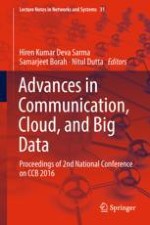This book is an outcome of the second national conference on Communication, Cloud and Big Data (CCB) held during November 10-11, 2016 at Sikkim Manipal Institute of Technology. The nineteen chapters of the book are some of the accepted papers of CCB 2016. These chapters have undergone review process and then subsequent series of improvements. The book contains chapters on various aspects of communication, computation, cloud and big data. Routing in wireless sensor networks, modulation techniques, spectrum hole sensing in cognitive radio networks, antenna design, network security, Quality of Service issues in routing, medium access control protocol for Internet of Things, and TCP performance over different routing protocols used in mobile ad-hoc networks are some of the topics discussed in different chapters of this book which fall under the domain of communication.
Moreover, there are chapters in this book discussing topics like applications of geographic information systems, use of radar for road safety, image segmentation and digital media processing, web content management system, human computer interaction, and natural language processing in the context of Bodo language. These chapters may fall under broader domain of computation.
Issues like robot navigation exploring cloud technology, and application of big data analytics in higher education are also discussed in two different chapters. These chapters fall under the domains of cloud and big data, respectively.
